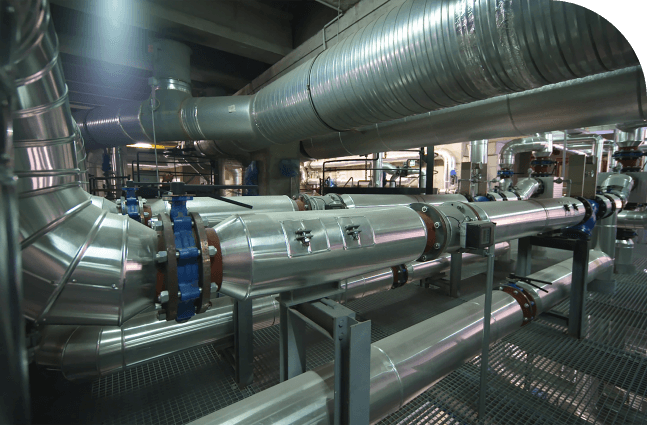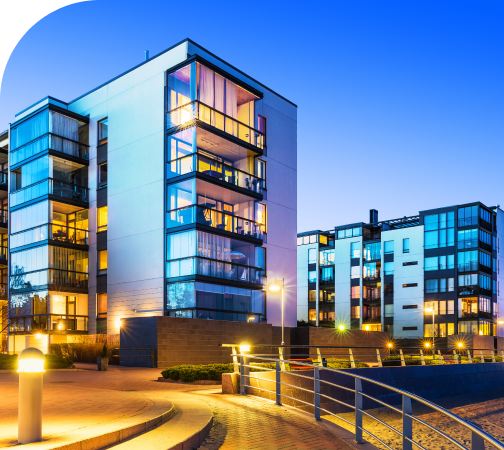

District heating
District heating is a form of heating that involves the distribution through insulated (underground) pipe networks of hot, overheated water or steam from a generating plant to urban centres.
One of the most important features of district heating is that it reduces CO2 and saves energy and money.
In addition, district heating systems can be combined with a generating unit powered by natural gas or renewable energy, involving the use of cogeneration. Through this important integration, a twofold benefit is achieved; the energy mix becomes more environmentally friendly and there is an increase in the efficiency of the energy system.
Benefits:
ENVIRONMENT
District heating enables the improvement of quality of air through the reduction of pollutants and gases for a greenhouse effect.

SAVINGS
District heating is a cheaper alternative with savings in utility bills.

SAFETY
District heating uses safer technologies that eliminate the combustion-related hazards inside boilers.

RATIONALISATION
District heating promotes rational use of energy resources with a focus on reducing fossil fuel consumption and local pollution.

PERFORMANCE
District heating involves improving the energy performance of Buildings (APE) resulting in an increase in the economic value of property.

MAINTENANCE
District heating allows a reduction in ordinary and extraordinary maintenance costs.

Benefits:
Environment
Savings
Safety
Rationalisation
Performance
Maintenance

RATIONALISATION
District heating promotes rational use of energy resources with a focus on reducing fossil fuel consumption and local pollution.

ENVIRONMENT
District heating enables the improvement of quality of air through the reduction of pollutants and gases for a greenhouse effect.

PERFORMANCE
District heating promotes rational use of energy resources with a focus on reducing fossil fuel consumption and local pollution.

SAVINGS
District heating is a cheaper alternative with savings in utility bills.

SAFETY
District heating uses safer technologies that eliminate the combustion-related hazards inside boilers.

MAINTENANCE
District heating allows a reduction in ordinary and extraordinary maintenance costs.
Statistics:
data updated to 2023
2,87 km
Lorme ipsum
160 km
Lorme ipsum
2,87 km
Lorme ipsum
160 km
Lorme ipsum
180 GWh
Heat
+ 1.900
customers supplied
55,47 tonnes
CO2 avoided
123 km
of network
over 263 MW
thermal power connected
3.642.431 m3
of heated utility volume
Statistics
data updated to 2023
180
GWh heat
+ 1.900
customers supplied
55,47
CO2 tonnes avoided
123
km of network
over 263
MW thermal power connected
3.642.431
m3 of heated utility volume
180 GWh
Heat
+ 1.900
Customers supplied
55,47 t
CO2 avoided
123 km
of network
over 263 MW
thermal power connected
3.642.431 m³
of heated utility volume
CONDOMINIUMS
Buildings and condominiums with central heating that still use old boilers, they lend themselves well to the introduction of a connection to the district heating network in order to lower the level of pollutant emissions. The service makes it possible to eliminate the depreciation cost of the old boiler system and also to reduce that of the Fire Safety Certificate.
PUBLIC ADMINISTRATIONS
All state and public administrations, including the institutes and schools of all levels and educational institutions, contemplating enormous heat and energy expenditure and which,
through this alternative energy supply system,can reduce their own costs on their bills. An increasing number of mayors and regional delegates are inclined to undertake work to connect public buildings to the district heating network in order to contribute to the reduction of CO2 emissions, to prepare for the goals set forth in Agenda 2030.
HOTELS
Tour operators increasingly continue to prefer green solutions, both to cut down on utility bills of their large, medium or small facilities both to reduce the CO2 emissions responsible for climate change and offer their customers the opportunity to experience environmentally sustainable travel whilst fully respecting the environment.
SWIMMING POOLS
The use of huge amounts of water, especially in receptive facilities such as swimming pools, requires a very high energy expenditure. Opting for a connection to the district heating network allows us to reduce expenses incurred and avoid costly and frequent plant maintenance with the boiler.
INDUSTRIES
Companies can contribute through the renovation of their own energy supply systems to the reduction of emissions of CO2 with a consequent reduction in the cost of the Fire Safety Certificate and maintenance of the facilities, as well as quieter primary parts.